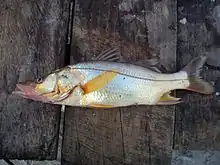Centropomus parallelus
Centropomus parallelus is a species of fish in the family Centropomidae, the snooks and robalos. It is known by several common names, including fat snook, smallscale fat snook, little snook, and chucumite.[2] It is native to the western Atlantic Ocean and Gulf of Mexico, its distribution extending from southern Florida in the United States to southern Brazil near Florianópolis.[3]
| Centropomus parallelus | |
|---|---|
 | |
| Scientific classification | |
| Domain: | Eukaryota |
| Kingdom: | Animalia |
| Phylum: | Chordata |
| Class: | Actinopterygii |
| Order: | Perciformes |
| Family: | Centropomidae |
| Genus: | Centropomus |
| Species: | C. parallelus |
| Binomial name | |
| Centropomus parallelus Poey, 1860 | |
Description
This fish is generally up to 25 cm long, but it has been known to reach 72 cm. The maximum published weight is 5 kg.[3] Like other snooks, it has a large head with a long, pointed snout and large, laterally positioned eyes. The large mouth has bands of villiform teeth. The body is yellowish brown to brownish green in color. It has a silvery sheen on the sides and belly and a dark line along the lateral line.[4]
Biology

This fish can tolerate a wide range of salinities and can be found in fresh, brackish, and marine waters. It can venture into high-salinity lagoons. It lives in many kinds of coastal habitat and is most often seen in fresh and mildly brackish water habitat types. It spawns in the brackish waters of estuaries.[3] This species is protandric, which means that some of the males change sex into females.[1]
This species is a carnivore with crustaceans making up a large part of its diet.[5] In experimental conditions, fat snook feed during the day, but during times of lower light, in the early morning and late afternoon.[6]
Recreational fishing for fat snook is growing in popularity in Brazil, where fishing tournaments target this species and congeneric common snook (C. undulatus).[7]
Aquaculture
This species is caught and sold as a food fish. Because of its market value it is studied for its potential as a farmed fish in the aquaculture industry. It is easy to rear in captivity, it can be raised on fish food rather than live prey, and it has a good feed conversion ratio, efficiently turning feed into meat.[8] So far researchers have achieved "massive production of juveniles" in the laboratory, and viable methods for commercial production are being studied.[9] In one successful trial, fat snook were grown from eggs placed in a substrate of Nannochloropsis algae, and the larvae that hatched were reared on a diet of rotifers and brine shrimp larvae. They were then "weaned" to a high-protein dry diet.[10]
Because it is a euryhaline fish, living in marine, brackish, and freshwater habitats, it can be farmed in a wide range of salinities.[11]
This species is protandrous, the form of sequential hermaphroditism in which males change to the female sex as they grow.[12] Females grow better than males, yielding more output. Researchers have experimented with dosing tanks of fish with the female sex hormone estradiol to produce all-female stocks, with promising results.[8]
References
- Mendonça, J.T.; Chao, L.; Albieri, R.J.; Giarrizzo, T.; Fadré, N.N.; da Silva, F.M.S.; Brick Peres, M.; Castro, M.G.; Villwock de Miranda, L.; Vieira, J.P.; Daniels, A. (2019). "Centropomus parallelus". IUCN Red List of Threatened Species. 2019: e.T190327A82662519. doi:10.2305/IUCN.UK.2019-2.RLTS.T190327A82662519.en. Retrieved 19 November 2021.
- Froese, R. and D. Pauly, eds. Common names of Centropomus parallelus. FishBase. 2014.
- Froese, Rainer; Pauly, Daniel (eds.) (2019). "Centropomus parallelus" in FishBase. December 2019 version.
- McEachran, J. D. and J. D. Fechhelm. Fishes of the Gulf of Mexico, Volume 2: Scorpaeniformes to Tetraodontiformes. University of Texas Press. 2006. pp 97 and 101.
- Contente, R. F., et al. (2009). Size-related shifts in dietary composition of Centropomus parallelus (Perciformes: Centropomidae) in an estuarine ecosystem of the southeastern coast of Brazil. Journal of Applied Ichthyology 25(3) 335–42.
- Tsuzuki, M. Y., et al. (2008). Growth of juvenile fat snook Centropomus parallelus in cages at three stocking densities. B. Inst. Pesca, São Paulo, 34(2) 319-24.
- Lennox, Robert J.; Brownscombe, Jacob W.; Cooke, Steven J.; Danylchuk, Andy J.; Moro, Pietro S.; Sanches, Eduardo A.; Garrone-Neto, Domingos (2015-08-01). "Evaluation of catch-and-release angling practices for the fat snook Centropomus parallelus in a Brazilian estuary". Ocean & Coastal Management. 113: 1–7. doi:10.1016/j.ocecoaman.2015.05.005. hdl:11449/167825. ISSN 0964-5691.
- de Carvalho, C. V. A., et al. (2014). Feminization and growth of juvenile fat snook Centropomus parallelus fed diets with different concentrations of estradiol-17β. Aquaculture International 22 1391-1401.
- Tsuzuki, M. Y., et al. (2007). Salinity tolerance of laboratory reared juveniles of the fat snook Centropomus parallelus. Brazilian Journal of Oceanography 55(1) 1-5.
- Alvarez-Lajonchegre, L., et al. (2002). Mass production of juveniles of the fat snook Centropomus parallelus in Brazil. Journal of the World Aquaculture Society 33(4) 506–16.
- Medeiros, L. S., et al. Ammonia excretion in fat snook (Centropomus parallelus Poey, 1860) at different salinities. Aquaculture Research epub ahead of print, April 2, 2014.
- Crain, B. J. and W. A. Gould. 2012 (Draft). Fat snook (Centropomus parallelus) – species natural history in Puerto Rico and the U.S. Virgin Islands. IITF-SR-##. Río Piedras, Puerto Rico: USDA Forest Service, International Institute of Tropical Forestry.
Further reading
- Oss, R. N., et al. (2013). Recovery of fat snook, Centropomus parallelus (Teleostei: Perciformes) after subchronic exposure to copper. Comparative Biochemistry and Physiology Part C: Toxicology & Pharmacology 157(3) 306-09.
- Tondolo, J. S. M., et al. (2013). Anesthesia and transport of fat snook Centropomus parallelus with the essential oil of Nectandra megapotamica (Spreng.) Mez. Neotropical Ichthyology 11(3) 667-74.
